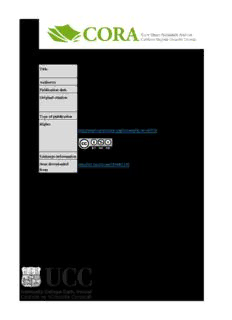
Downloaded on 2017-08-01T18:14:31Z PDF
Preview Downloaded on 2017-08-01T18:14:31Z
UCC Library and UCC researchers have made this item openly available. Please let us know how this has helped you. Thanks! Title A knowledge management system to optimise comfort throughout the building life-cycle Author(s) O'Grady, Walter Publication date 2013 Original citation O'Grady, W. 2013. A knowledge management system to optimise comfort throughout the building life-cycle. PhD Thesis, University College Cork. Type of publication Doctoral thesis Rights © 2013. Walter O'Grady. http://creativecommons.org/licenses/by-nc-nd/3.0/ Embargo information No embargo required Item downloaded http://hdl.handle.net/10468/1140 from Downloaded on 2023-01-14T01:08:12Z A Knowledge Management System to Optimise Comfort throughout the Building Life- Cycle Walter O’Grady Supervisors: Dr. Marcus Keane and Dr Dominic O’Sullivan Head of Department: Prof. Alistair Borthwick Department: Civil and Environmental Engineering Institution: National University of Ireland, Cork Submitted for: The degree of Doctor of Philosophy Date: April 2013 II Talk to Strangers III IV Abstract Comfort is, in essence, satisfaction with the environment, and with respect to the indoor environment it is primarily satisfaction with the thermal conditions and air quality. Improving comfort has social, health and economic benefits, and is more financially significant than any other building cost. Despite this, comfort is not strictly managed throughout the building lifecycle. This is mainly due to the lack of an appropriate system to adequately manage comfort knowledge through the construction process into operation. Previous proposals to improve knowledge management have not been successfully adopted by the construction industry. To address this, the BabySteps approach was devised. BabySteps is an approach, proposed by this research, which states that for an innovation to be adopted into the industry it must be implementable through a number of small changes. This research proposes that improving the management of comfort knowledge will improve comfort. ComMet is a new methodology proposed by this research that manages comfort knowledge. It enables comfort knowledge to be captured, stored and accessed throughout the building life- cycle and so allowing it to be re-used in future stages of the building project and in future projects. It does this using the following: Comfort Performances – These are simplified numerical representations of the comfort of the indoor environment. Comfort Performances quantify the comfort at each stage of the building life- cycle using standard comfort metrics; Comfort Ratings - These are a means of classifying the comfort conditions of the indoor environment according to an appropriate standard. Comfort Ratings are generated by comparing different Comfort Performances. Comfort Ratings provide additional information relating to the comfort conditions of the indoor environment, which is not readily determined from the individual Comfort Performances. V Comfort History – This is a continuous descriptive record of the comfort throughout the project, with a focus on documenting the items and activities, proposed and implemented, which could potentially affect comfort. Each aspect of the Comfort History is linked to the relevant comfort entity it references. These three components create a comprehensive record of the comfort throughout the building lifecycle. They are then stored and made available in a common format in a central location which allows them to be re-used ad infinitum. The LCMS System was developed to implement the ComMet methodology. It uses current and emerging technologies to capture, store and allow easy access to comfort knowledge as specified by ComMet. LCMS is an IT system that is a combination of the following six components: Building Standards; Modelling & Simulation; Physical Measurement through the specially developed Egg-Whisk (Wireless Sensor) Network; Data Manipulation; Information Recording; Knowledge Storage and Access. Results from a test case application of the LCMS system - an existing office room at a research facility - highlighted that while some aspects of comfort were being maintained, the building’s environment was not in compliance with the acceptable levels as stipulated by the relevant building standards. The implementation of ComMet, through LCMS, demonstrates how comfort, typically only considered during early design, can be measured and managed appropriately through systematic application of the methodology as means of ensuring a healthy internal environment in the building. VI VII VIII Dedication To Elmer, Since you were the better story teller in our duo, I’ll let you do your dedication. Why break a successful tradition :-). Advice By Elmer Morrissey “Prioritise a path that ensures you have enough Walter time in an environment that will support growth (spiritual/mental/whatever). Ultimately, what I'm advising is don't take an easy option that your gut rebels against. Back yourself and take charge. That may involve risks, or it may be an open door right where you are. But…, be careful how far you take rational thought, go with feeling without limits. Make whatever you want happen, don't force it or anything, just seek it. You'll know when you find it.” I miss you. IX
Description: